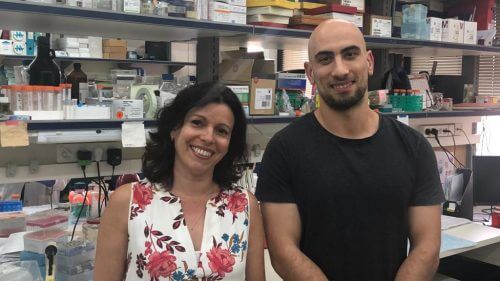Researchers from Tel Aviv University have uncovered a mechanism by which breast cancer cells 'trick' the body and recruit healthy mechanisms for the benefit of the tumor; The innovative method blocks the mechanism and inhibits the development of metastases * The study was recently published in the journal Nature Communications

Researchers at Tel Aviv University, led by Prof. Neta Erez, head of the Department of Pathology at the Faculty of Medicine, discovered a mechanism by which breast cancer cells recruit the normal systems in the body, so that they support the development of the tumor, and even help to create metastases. The research was carried out by doctoral students Dr. Noor Arscheid and Dr. Yuri Sharon. This is an inflammatory pathway which, in a normal state, is meant to heal wounds and tissue damage, but cancer harnesses it for its purposes. Blocking the inflammatory pathway by means of genetic engineering stopped tumor development in mice in a breast cancer model, and resulted in a significant reduction in the number of metastases in their lungs. The researchers believe that this is a new and promising approach for future treatment and prevention of metastasis in breast cancer and even other types of cancer.
The research was recently published in the journal Nature Communications
"Cancer is a cunning enemy, which manages to 'cheat' the body's systems, and mobilize them for its needs," explains Prof. Erez. "In our research we focused on connective tissue cells called fibroblasts (fiber cells). In a normal state, fibroblasts play a central role in healing wounds and tissue damage, but studies from recent years have revealed that they are also associated with pro-cancer inflammatory processes. We wanted to find the mechanism and find out exactly how the fibroblasts are recruited to help the cancer."
The researchers used mice in a breast cancer model. First, they took fibroblastic cells from females in three conditions - healthy lungs without cancer, with an initial tumor and with an advanced tumor that metastasizes to the lungs - and examined the presence of different proteins in the tissues. "In the fibroblasts taken from the sick mice, as well as from about 80 women with breast cancer, we discovered to our surprise an overexpression of proteins indicative of an inflammatory pathway called 'inflammasome,'" says Prof. Erez. "This pathway is well known to us from the cells of the immune system: it allows them to detect tissue damage, and call additional cells of the immune system to the scene, in order to produce inflammation that will fight the damage. But to date, the inflammasome pathway has never been observed in fibroblasts." To confirm the surprising finding, the researchers exposed fibroblasts from a healthy breast to a variety of substances that signal tissue damage, including fluid taken from a cancerous tumor. In all cases the fibroblasts reacted and expressed proteins indicative of the inflammasome pathway. Another test showed inflammasome formation in fibroblasts also in response to a skin wound.
"We realized that we discovered a new action of fibroblasts, which was not known until now: they know how to detect tissue damage, and create an inflammatory pathway that calls for the cells of the immune system to arrive en masse," says Prof. Erez. "In the case of breast cancer, the tumor environment is characterized by extensive cell death, and significant damage to the underlying tissues. The fibroblasts receive the molecular signals coming from the damaged tissues, and produce an inflammatory process around them. Now we wanted to check if and how the inflammation specifically serves the cancer, or in other words: is it a mechanism by which the cancerous tumor 'deceives' the normal cells and recruits them to its advantage?"
To test this, the researchers on the mouse model for breast cancer, and through genetic engineering blocked the production of the proteins of the inflammatory pathway in fibroblasts. The findings were clear: blocking the inflammatory mechanism resulted in a delay in tumor development, and in cases of metastatic cancer, the number of metastases even decreased. "From this it can be concluded that the inflammatory mechanism does support the development of cancer, and moreover, that it helps by remote control for the development of metastases in other organs," says Prof. Erez. How does that happen? First, according to her, the tumor itself uses growth factors that arrive at the site to help fuse the damaged tissue; and secondly, the inflammatory mechanism makes the blood vessels more permeable in order to allow as many cells as possible of the immune system to quickly reach the damaged place (this is the reason for the swelling and redness that we all recognize as inflammation); Cancer cells take advantage of the permeable blood vessels to easily enter the bloodstream, migrate and settle in other organs.
"In our research, we discovered an unknown mechanism in fibroblasts in general and breast fibroblasts in particular: similar to the cells of the immune system, they are also able to detect tissue damage and activate an inflammatory pathway that recruits cells of the immune system to the damaged site," concludes Prof. Erez. "We also found that this normal reaction is mobilized by the cancerous tumor in the breast, to support its development, and to send metastases to other organs (in this study we focused on the lungs, and in a follow-up study we are examining the effect of the mechanism we discovered on the development of bone metastases). In addition, we believe that the mechanism we discovered forms the basis for a new approach to breast cancer treatment: future drugs that block the inflammatory pathway in fibroblasts will be able to reduce the tumor and even prevent metastases. This type of treatment may be given to women after surgery to remove the breast tumor, in order to prevent a metastatic recurrence of the disease. We also believe that the method may also be suitable for other types of cancerous tumors."
